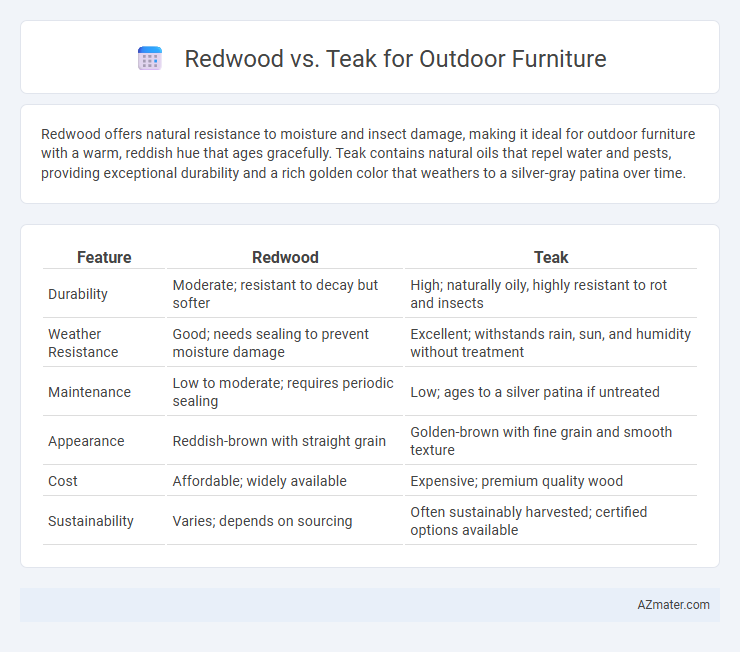Redwood offers natural resistance to moisture and insect damage, making it ideal for outdoor furniture with a warm, reddish hue that ages gracefully. Teak contains natural oils that repel water and pests, providing exceptional durability and a rich golden color that weathers to a silver-gray patina over time.
Table of Comparison
| Feature | Redwood | Teak |
|---|---|---|
| Durability | Moderate; resistant to decay but softer | High; naturally oily, highly resistant to rot and insects |
| Weather Resistance | Good; needs sealing to prevent moisture damage | Excellent; withstands rain, sun, and humidity without treatment |
| Maintenance | Low to moderate; requires periodic sealing | Low; ages to a silver patina if untreated |
| Appearance | Reddish-brown with straight grain | Golden-brown with fine grain and smooth texture |
| Cost | Affordable; widely available | Expensive; premium quality wood |
| Sustainability | Varies; depends on sourcing | Often sustainably harvested; certified options available |
Comparing Redwood and Teak: An Overview
Redwood offers natural resistance to decay and insects, featuring a warm reddish hue that ages to a soft gray, making it ideal for weather-exposed outdoor furniture. Teak contains high natural oil content, ensuring superior durability, water resistance, and minimal maintenance while developing a silvery patina over time. Both woods rank high in sustainability and longevity, but teak's dense grain and robust strength often justify its premium price for long-term outdoor use.
Durability and Weather Resistance
Redwood exhibits excellent durability and weather resistance due to its natural oils and dense grain, making it highly resistant to rot, decay, and insect damage in outdoor environments. Teak is renowned for its exceptional weather resistance, with high oil content and tight grain that protect it from moisture, warping, and UV damage, allowing it to withstand harsh climates for decades. Both woods offer superior outdoor longevity, but teak generally outperforms redwood in extreme weather conditions and requires less maintenance to preserve its structural integrity.
Appearance and Color Differences
Redwood displays a rich reddish-brown hue with natural variations that deepen over time, offering a warm, classic aesthetic for outdoor furniture. Teak boasts a golden to medium brown tone that ages gracefully into an elegant silvery-gray patina when exposed to the elements. The distinct grain patterns and color retention properties of teak make it a popular choice for luxurious, durable outdoor pieces compared to the more vibrant and bold appearance of redwood.
Maintenance Requirements
Redwood outdoor furniture requires minimal maintenance due to its natural resistance to decay, insects, and moisture, needing only occasional cleaning and sealing to preserve its appearance. Teak demands more frequent upkeep, including regular oiling to maintain its rich color and prevent weathering, despite its natural oils that offer durability and resistance to rot. Both woods benefit from protective finishes to extend their lifespan and resist outdoor elements effectively.
Eco-Friendliness and Sustainability
Redwood, sourced from sustainably managed forests, offers a renewable and biodegradable option for outdoor furniture, while teak, often harvested from slow-growing tropical trees, poses higher concerns regarding deforestation and habitat loss. Redwood's naturally occurring resistance to decay reduces the need for chemical treatments, enhancing its eco-friendliness compared to teak, which may require additional finishes to maintain durability. Choosing FSC-certified redwood ensures lower environmental impact, promoting sustainable forest management and biodiversity conservation.
Cost Comparison: Redwood vs Teak
Redwood outdoor furniture typically costs less than teak due to its faster growth rate and greater availability, making it a more budget-friendly option. Teak's higher price stems from its natural oils and durability, which provide superior resistance to weather and insects, justifying the investment for long-term use. While teak may have a higher upfront cost, its longevity and minimal maintenance often result in lower overall expenses compared to redwood over time.
Weight and Workability
Redwood is lighter than teak, making it easier to move and handle during outdoor furniture installation. Teak's dense, oily wood offers superior workability with hand and power tools but requires careful handling due to its hardness. Both woods provide durable options, but redwood's lower weight can reduce strain while teak demands more skill for shaping and finishing.
Suitability for Different Climates
Redwood's natural resistance to moisture and decay makes it ideal for humid and coastal climates, preventing warping and rot in outdoor furniture. Teak's high oil content and dense grain provide exceptional durability and weather resistance, thriving in hot, sunny environments while aging gracefully to a silver-gray patina. Both woods perform well outdoors but selecting Redwood suits damp regions, whereas Teak excels in areas with intense sun and occasional rain.
Lifespan and Long-Term Value
Redwood offers excellent natural resistance to decay and insects, ensuring a lifespan of 15 to 30 years for outdoor furniture, making it a cost-effective option for long-term use. Teak, with its high oil content and dense grain, can last over 50 years when properly maintained, providing superior durability and value despite a higher initial investment. Choosing teak maximizes long-term value through reduced maintenance and unparalleled weather resistance, while redwood balances affordability with moderate longevity for outdoor applications.
Final Verdict: Which Wood is Best for Outdoor Furniture?
Redwood offers excellent natural resistance to moisture, decay, and insects, making it highly durable and low-maintenance for outdoor furniture. Teak is renowned for its exceptional hardness, oily grain that repels water, and long-lasting durability even in harsh weather conditions. For outdoor furniture, teak generally ranks superior due to its unparalleled strength and weather resistance, while redwood remains a solid cost-effective option for moderate climates.

Infographic: Redwood vs Teak for Outdoor Furniture
 azmater.com
azmater.com